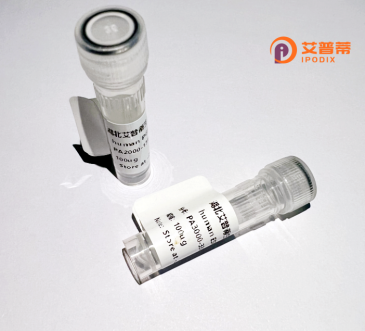
| 纯度 | >90%SDS-PAGE. |
| 种属 | Human |
| 靶点 | CCRL1 |
| Uniprot No | Q9NPB9 |
| 内毒素 | < 0.01EU/μg |
| 表达宿主 | E.coli |
| 表达区间 | 1-350aa |
| 氨基酸序列 | MALEQNQSTDYYYEENEMNGTYDYSQYELICIKEDVREFAKVFLPVFLTIVFVIGLAGNSMVVAIYAYYKKQRTKTDVYILNLAVADLLLLFTLPFWAVNAVHGWVLGKIMCKITSALYTLNFVSGMQFLACISIDRYVAVTKVPSQSGVGKPCWIICFCVWMAAILLSIPQLVFYTVNDNARCIPIFPRYLGTSMKALIQMLEICIGFVVPFLIMGVCYFITARTLMKMPNIKISRPLKVLLTVVIVFIVTQLPYNIVKFCRAIDIIYSLITSCNMSKRMDIAIQVTESIALFHSCLNPILYVFMGASFKNYVMKVAKKYGSWRRQRQSVEEFPFDSEGPTEPTSTFSI |
| 分子量 | 39.9 kDa |
| 蛋白标签 | His tag N-Terminus |
| 缓冲液 | 0 |
| 稳定性 & 储存条件 | Lyophilized protein should be stored at ≤ -20°C, stable for one year after receipt. Reconstituted protein solution can be stored at 2-8°C for 2-7 days. Aliquots of reconstituted samples are stable at ≤ -20°C for 3 months. |
| 复溶 | Always centrifuge tubes before opening.Do not mix by vortex or pipetting. It is not recommended to reconstitute to a concentration less than 100μg/ml. Dissolve the lyophilized protein in distilled water. Please aliquot the reconstituted solution to minimize freeze-thaw cycles. |
以下是3篇关于人CCRL1蛋白的参考文献及其摘要概述:
---
1. **文献名称**:*CCRL2 interacts with chemokine–proteoglycan complexes and supports β1-integrin-mediated adhesion of leukocytes*
**作者**:Rot, A. et al.
**摘要**:该研究揭示了CCRL1作为非典型趋化因子受体在免疫细胞中的功能,发现其通过结合硫酸肝素蛋白多糖增强β1-整联蛋白介导的白细胞黏附,影响炎症反应中的细胞迁移。
2. **文献名称**:*The chemerin receptor CCRL1 regulates cGMP signaling and neutrophil trafficking*
**作者**:Zabel, B.A. et al.
**摘要**:研究发现CCRL1通过调控环磷酸鸟苷(cGMP)信号通路,调节中性粒细胞的迁移和活化,提示其在炎症性疾病如脓毒症中的潜在作用。
3. **文献名称**:*CCRL1 is a receptor for chemerin and contributes to the recruitment of NK cells into inflamed tissues*
**作者**:Pachynski, R.K. et al.
**摘要**:论文证实CCRL1是趋化素(chemerin)的功能性受体,参与自然杀伤细胞(NK细胞)向炎症组织的募集,为肿瘤免疫和自身免疫疾病研究提供新视角。
---
**备选文献**(如需第4篇):
4. **文献名称**:*Structural insights into the interaction of CCRL1 with chemerin-derived peptides*
**作者**:Liu, Q. et al.
**摘要**:通过晶体结构解析,阐明CCRL1与趋化素衍生肽的结合机制,为靶向CCRL1的药物设计提供结构基础。
---
提示:上述文献可通过PubMed或Google Scholar输入标题搜索原文。建议结合具体研究方向筛选合适文献。
Chemokine (C-C motif) receptor-like 1 (CCRL1), also known as ChemR23 or CMKLR1. is an atypical chemokine receptor encoded by the *CCRL1* gene in humans. Unlike classical G protein-coupled chemokine receptors, CCRL1 lacks a conserved DRY motif critical for G protein signaling, suggesting alternative functional roles. Primarily expressed on immune cells (e.g., neutrophils, dendritic cells) and endothelial cells, it binds chemoattractants like chemerin and resolvin E1. linking innate immunity with inflammatory resolution.
CCRL1 functions as a scavenger or presentation receptor, modulating chemokine bioavailability or facilitating ligand delivery to signaling receptors (e.g., CCR1/CCR5). It regulates leukocyte migration, angiogenesis, and tissue homeostasis. Notably, it plays dual roles in inflammation: promoting early immune responses by recruiting leukocytes and resolving inflammation via specialized pro-resolving mediators.
Its involvement in pathologies includes rheumatoid arthritis, sepsis, and cancer metastasis. Recombinant human CCRL1 protein, produced through mammalian or insect cell systems, retains structural integrity for functional studies. It serves as a tool to dissect CCRL1-ligand interactions, signaling crosstalk, and therapeutic targeting in dysregulated immune or angiogenic processes. Current research focuses on its paradoxical roles in inflammation-cancer interplay and potential as a biomarker or immunomodulatory target.
×